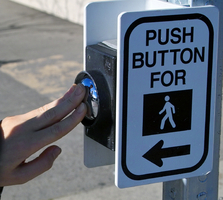Crosswalk placebos

I'm reading Henry Petroski's Success through Failure: The Paradox of Design (and quite enjoying it).
While illustrating that "the connection between intention and result, between cause and effect, is not always what it seems" Petroski sheds light on a great mystery I've wondered about before: does pushing the crosswalk button actually accomplish anything?
Blaming an unfortunate occurence on bad design may make for a convincing damage claim—or even a succesful lawsuit—but the connection between intention and result, between cause and effect, is not always what it seems. Over three thousand intersections in New York City have signs instructing pedestrians, "To Cross Street / Push Button / Wait for Walk Signal." A good deal of time often elapses between pushing the button and getting the go-ahead, but conscientous citizens obediently wait. They presume, one presumes, that a delay is part of the system's design. It may be a "bad design," but the light does change—eventually.
New York intersections began to be fitted with these "semi-articulated signals" around 1964. They were the "brainstorm of the legendary traffic commissioner, Henry Barnes, the inventor of the 'Barnes Dance,' the traffic system that stops all vehicles in the intersection and allows pedestrians to cross in every direction at the same time." Walk buttons were installed mostly where a minor street intersected a major one, along which traffic would be stopped only if a pavement sensor detected a vehicle waiting to enter from the minor street or if someone pushed the button, causing the light to change ninety seconds hence. With increased traffic (by 1975, about 750,000 vehicles were entering Manhattan daily), the signals were being tripped frequently by minor-street traffic. The walk button hardly seemed necessary, and pushing them interfered with the coordination of newly installed computer-controlled traffic lights among many thoroughfares. Consequently, most of the devices were deactivated by the late 1980s, but the buttons themselves and the signs bearing the instructions for their use remained in place. Evidently there was never any official announcement about the status of the "mechanical placebos."
Which doesn't necessarily mean the buttons are placebos anywhere other than New York, but it does make one wonder...
—Michael A. Cleverly
Monday, August 14, 2006 at 22:08